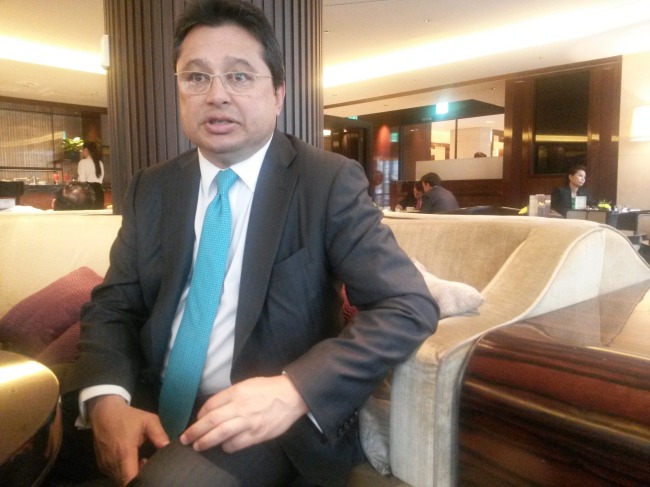Paraguay eyes Korean investment
Public-private partnerships could draw Korean investment
By Korea HeraldPublished : Sept. 21, 2014 - 18:51
South Korean investment in South America has mostly poured into countries such as Chile, Peru and Colombia, three important commercial partners with which East Asia’s third-largest economy also has free trade agreements.
But recent changes in Paraguay, a rural, landlocked country that borders Argentina and Brazil, could very well redirect the investment attention of Korea Inc.
“My aim here is to start a continuous process of putting Panama on the map for investment,” said Gustavo Leite, Paraguay’s minister of industry and commerce, in an interview with The Korea Herald in Seoul on Tuesday.
He was in Seoul for investment conferences and to meet with corporate executives and government officials.
When Paraguayan President Horacio Cartes took office in August 2013, the businessman-turned-politician set out three ambitious goals: to end extreme poverty, maintain robust economic growth and integrate Paraguay into the world economy.
“Nos. 2 and 3 are more related to the job of the Minister of Industry, and I am here in Korea for No. 3: To awaken the interest and increase awareness of Korean and Chinese businesses about Paraguay,” he said, referring to Cartes’ goals.
But recent changes in Paraguay, a rural, landlocked country that borders Argentina and Brazil, could very well redirect the investment attention of Korea Inc.
“My aim here is to start a continuous process of putting Panama on the map for investment,” said Gustavo Leite, Paraguay’s minister of industry and commerce, in an interview with The Korea Herald in Seoul on Tuesday.
He was in Seoul for investment conferences and to meet with corporate executives and government officials.
When Paraguayan President Horacio Cartes took office in August 2013, the businessman-turned-politician set out three ambitious goals: to end extreme poverty, maintain robust economic growth and integrate Paraguay into the world economy.
“Nos. 2 and 3 are more related to the job of the Minister of Industry, and I am here in Korea for No. 3: To awaken the interest and increase awareness of Korean and Chinese businesses about Paraguay,” he said, referring to Cartes’ goals.

South Korea has a long history with Paraguay by virtue of Korean emigration to the South American country. In terms of commercial and investment contacts, the relationship has been minimal.
Some 120,000 Koreans are believed to have immigrated to the South American country in the 1960s, but that number later fell drastically as most resettled in Brazil.
Paraguay is slightly larger than Japan, sandwiched between southern Brazil and northern Argentina, with a population of 6.5 million. Today, however, only about 5,000 reside in the country, according to figures from the Ministry of Foreign Affairs.
Now things appear to be turning around. Only $4 million was invested by 2010 by South Korean firms, according to MOFA figures. And, until recently, Paraguay itself had invested little in terms of infrastructure development.
Legislation on public-private partnerships passed in October, shortly after Cartes’ election, could attract significantly higher levels of foreign direct investment to the country. That could have made the difference attracting attention from South Korean companies and government officials for the small South American country.
President Cartes introduced PPPs as a way to attract foreign investment in infrastructure projects and modernize Paraguay, which is one of the poorest countries in Latin America.
In 2011, infrastructure investment was $400 million, about 2 percent of GDP and much lower than the other countries in the region, according to a report by the Development Bank of Latin America.
After recovering from a slump in 2012, the Paraguayan economy surged 14 percent in 2013, and on-year growth in the first quarter of 2014 was estimated at 14 percent. But some 35 percent of the population remained below the poverty line in 2009 in a country with per capita income of $2,700 in 2010, according to the International Fund for Rural Development.
Paraguay aims to invest $7.5 billion in infrastructure development over the next five years, and South Korean companies could win a significant percentage of coming construction projects.
“(A PPP) is one of the motives (for Korean interest). However, today we took part in a forum on Korea-Latin American investment. The conclusion at the forum was that as Korea develops, Korean companies become more international. That means Korean companies are looking for new markets and for profitability now. Paraguay as a market is not big, but as a platform for profitability, it is formidable. That will be discovered more and more by Korean companies.
“Paraguay has undergone a 25-year post-dictatorship transition into a full and vibrant democracy now. We can say our youth does not know any system other than democracy, which is good, and we have also had 10 uninterrupted years of very sound macroeconomic management,” explained Leite. “This gives us a good base to grow and attract foreign direct investment.”
He described two early indications of South Korean interest. Auto parts supplier THN Corporation opened a manufacturing plant in a small town in Paraguay to service auto manufacturing sectors in Brazil and Argentina. Ilsung Construction inked a deal to build a new 72-kilometer expressway in April.
Next year, the two countries will commemorate the 50th anniversary of Korean immigration to Paraguay. They will celebrate Koreans who have achieved prominent positions in Paraguayan society.
By Philip Iglauer (ephilip2014@heraldcorp.com)
-
Articles by Korea Herald







![[Graphic News] More Koreans say they plan long-distance trips this year](http://res.heraldm.com/phpwas/restmb_idxmake.php?idx=644&simg=/content/image/2024/04/17/20240417050828_0.gif&u=)
![[KH Explains] Hyundai's full hybrid edge to pay off amid slow transition to pure EVs](http://res.heraldm.com/phpwas/restmb_idxmake.php?idx=644&simg=/content/image/2024/04/18/20240418050645_0.jpg&u=20240419100350)






![[From the Scene] Monks, Buddhists hail return of remains of Buddhas](http://res.heraldm.com/phpwas/restmb_idxmake.php?idx=652&simg=/content/image/2024/04/19/20240419050617_0.jpg&u=20240419175937)

![[KH Explains] Hyundai's full hybrid edge to pay off amid slow transition to pure EVs](http://res.heraldm.com/phpwas/restmb_idxmake.php?idx=652&simg=/content/image/2024/04/18/20240418050645_0.jpg&u=20240419100350)

![[Today’s K-pop] Illit drops debut single remix](http://res.heraldm.com/phpwas/restmb_idxmake.php?idx=642&simg=/content/image/2024/04/19/20240419050612_0.jpg&u=)